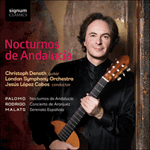
Welcome to Hyperion Records, a British classical label devoted to presenting high-quality recordings of music of all styles and from all periods from the twelfth century to the twenty-first.
Hyperion offers both CDs, and downloads in a number of formats. The site is also available in several languages.
Please use the dropdown buttons to set your preferred options, or use the checkbox to accept the defaults.

| Christoph Denoth (guitar), London Symphony Orchestra, Jesús López Cobos (conductor)» More |


The work was first performed at the Palau de la Musica, Barcelona on 9 November 1940, with Regino Sainz de la Maza, the work’s dedicatee as soloist and César Mendoza Lasalle conducting the Barcelona Philharmonic Orchestra. Many press commentators immediately recognised its importance to the country’s musical canon, praising its fusion of classical music with distinctly Spanish influences. Six years later Narciso Yepes was introduced to Rodrigo, who gave him the manuscript. Rising to the challenge of the new and formidable technical difficulties in the guitar part, Yepes’ performances in the late 1940s, when still only in his early 20s, brought international fame to the work as well as recognition of his own talent. His first performance in Paris brought forth the following rave review from the respected journal, The Strad
A concert with the Paris Conservatoire Orchestra…included a splendidly restrained performance with Narciso Yepes of Joaquín Rodrigo’s Guitar Concerto. This must surely be the only successful concerto written for the instrument. The beautiful balance of ideas and harmonies, the sensitive atmosphere and orchestration are an ever fresh delight.
As with many classical piece which have assumed international popular success, the concerto has now and then been less appreciated by critics than by audiences. Certainly it avoids the extremes of some twentieth-century music of the period, but it is far from conservative. Its melodies, idiom and textures spring from Rodrigo’s deep knowledge and love of Spanish culture, folklore and history and his distinctive musical voice and deft individual handling of orchestral sonority make for a work which is both modern and, as Rodrigo put it, ‘neo-casticisma’—‘faithful to tradition’. The great British guitarist, Julian Bream, had this to say about Rodrigo on his death: ‘The success of Concierto de Aranjuez has somehow eclipsed Rodrigo’s other works. They need to be brought out and rediscovered, and Rodrigo should not be considered the author of only one work because the future will undoubtedly reveal other treasures to us’. More than ten years on, Rodrigo’s works are being praised, performed recorded and rediscovered as never before—at least in part due to the fame of the Concierto.
from notes by M Ross © 2011
Même si Joaquín Rodrigo a composé Concierto de Aranjuez en 1939, bien après les œuvres innovantes écrites par Bartók, il s’agit d’une œuvre bien plus douce que la suite de Palomo, et cela pas seulement en raison du nombre réduit de musiciens (39) dans l’orchestre. Le caractère de l’œuvre tire certainement son inspiration des jardins, mais également de la situation politique dans laquelle Rodrigo a composé son concerto: la Guerre civile espagnole qui venait de s’achever avait renversé la Deuxième République pour imposer la dictature de Francisco Franco. Le nouveau régime recherchait une musique incarnant l’ordre, et l’œuvre de Rodrigo répondait à cette exigence, en célébrant les jardins d’un palais royal du XVIIIe siècle et en utilisant des nuances instrumentales espagnoles aux tonalités élégantes tout en restant reconnaissables. Le concerto de Rodrigo épouse la forme traditionnelle à trois mouvements du XVIIIe siècle familière à Mozart, dans laquelle les premier et troisième mouvements dynamiques alternent avec un mouvement lent mélodieux. Ici, les mouvements extérieurs du concerto présentent des éléments des rythmes entraînants de la musique espagnole, embellis comme s’ils devaient être présentés devant une cour royale, tandis que le mouvement central suggère une image plus subjective des jardins, où la chaleur est tempérée par l’influence du Tage et du Jarama.
extrait des notes rédigées par Daniel Jaffé © 2016
Français: Laëtitia Lord
Obwohl Rodrigo das Concierto de Aranjuez erst 1939 komponierte, also lange nachdem Bartók seine innovativen Werke schrieb, ist es ein viel heitereres Werk als Palomos Suite—und das nicht bloss, weil es für ein kleineres Orchester von nur 39 Musikern instrumentiert wurde. Der Charakter des Werks reflektiert wohl nicht nur die Gärten, die es inspirierten, sondern mit ziemlicher Sicherheit auch die politische Lage, in der Rodrigo sein Concerto komponierte: Der Spanische Bürgerkrieg war gerade erst zu Ende, hatte der Zweiten Spanischen Republik ein Ende bereitet und Francisco Franco zum autoritären Führer Spaniens gemacht. Was das neue Regime brauchte, war eine Musik, die der bestehenden Ordnung entsprach. Rodrigos Werk erfüllte diese Anforderung, indem es durch elegante und doch noch erkennbar spanische Rhythmen und Instrumentalklänge die Palastgärten des Monarchen aus dem 18. Jahrhundert zelebrierte. Darüber hinaus ist Rodrigos Concerto in der traditionellen, auch Mozart vertrauten Form des 18. Jahrhunderts gehalten, bei dem lebhafte erste und dritte Sätze einen wohlklingenden langsamen Satz umrahmen. Hier erinnern die Ecksätze des Concertos etwas an die lebhaften Tanzrhythmen der spanischen Musik, herausgeputzt wie für eine Präsentation am königlichen Hof, während der Mittelsatz ein subjektiveres Bild der Gärten zeichnet: warm, aber gut bewässert durch die Flüsse Tagus und Jarama.
aus dem Begleittext von Daniel Jaffé © 2016
Deutsch: Suzanne Leu
 Palomo: Nocturnos de Andalucía; Rodrigo: Concierto de Aranjuez Palomo: Nocturnos de Andalucía; Rodrigo: Concierto de AranjuezThree much-loved works for guitar and orchestra from one of the foremost guitarists of his generation, the London Symphony Orchestra and conductor Jesús López Cobos.» More |

